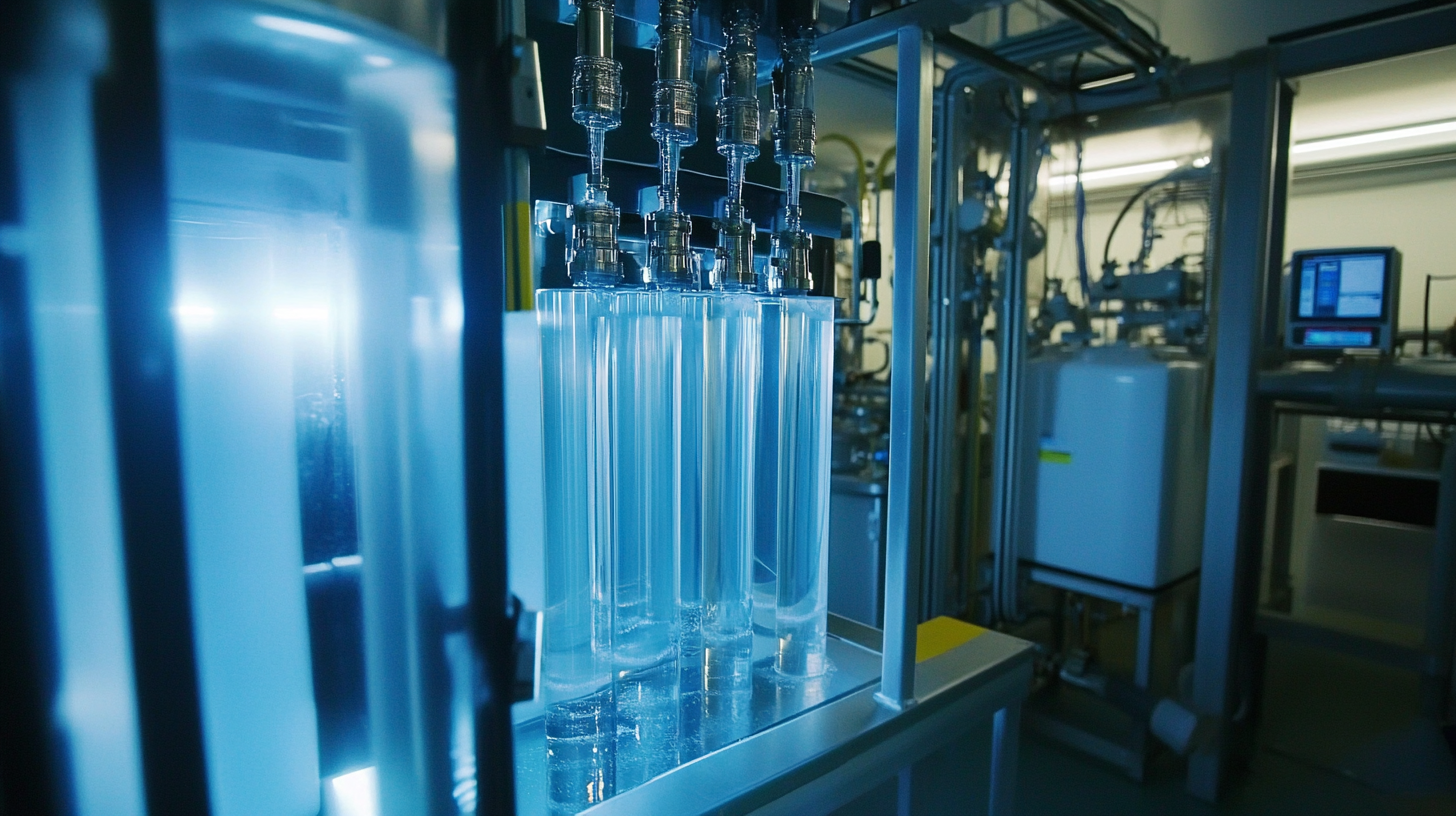Leave Your Message
Request a Quote
As global water scarcity intensifies, the need for advanced purification technologies has never been more critical. The market for water treatment is projected to reach $169.6 billion by 2025, with nanofiltration systems emerging as a leading solution due to their efficiency and effectiveness in removing contaminants. A report by ResearchAndMarkets indicates that nanofiltration membranes, characterized by their selective permeability, can effectively filter out divalent and multivalent ions while allowing monovalent ions to pass, making them ideal for applications ranging from municipal water treatment to industrial wastewater management. With a growing emphasis on sustainable and cost-effective methods, the adoption of nanofiltration systems is poised to revolutionize the water purification landscape, offering an innovative approach to meeting the world’s water demands.

Nanofiltration is a cutting-edge technology that sits between ultrafiltration and reverse osmosis in the filtration spectrum, making it particularly effective for water purification. The core principle of nanofiltration lies in its ability to remove divalent and larger monovalent ions from water while allowing smaller monovalent ions and water molecules to pass through. This selective permeability is achieved through membrane technology that features pores typically ranging from 1 to 10 nanometers in size. As a result, nanofiltration systems are particularly useful in applications such as softening water by removing hardness-causing minerals like calcium and magnesium.
The mechanisms behind nanofiltration involve both size exclusion and charge repulsion. As water flows through the membrane, particles larger than the nanopores are trapped, while smaller particles and ions can pass through. Additionally, the charge of the membrane plays a crucial role; it can repel or attract certain ions based on their charge, enhancing the filtration efficiency. This dual mechanism not only improves the quality of the purified water but also optimizes energy consumption and operational costs, positioning nanofiltration as an essential technology in the future of water treatment solutions. The growing interest in sustainable practices highlights the importance of exploring these mechanisms further, as they hold the promise for achieving cleaner water without the heavy environmental footprint associated with traditional methods.
This pie chart illustrates the key benefits of nanofiltration systems in water purification, highlighting their effectiveness in removing organic compounds and bacteria, their energy efficiency, and cost-effectiveness.
Nanofiltration (NF) systems are revolutionizing the landscape of water purification with their ability to effectively remove contaminants while retaining essential minerals. This advanced filtration technology operates between ultra-filtration and reverse osmosis, making it particularly valuable for treating various water sources, including municipal, industrial, and agricultural water. The unique pore size of NF membranes allows for the selective removal of divalent and larger monovalent ions, as well as organic compounds, which are often the main culprits in water quality degradation.
One prominent application of nanofiltration is in the treatment of wastewater, where it can significantly reduce the concentration of harmful pollutants, including heavy metals and organic molecules. Additionally, NF systems are being utilized in drinking water treatment processes to enhance water quality by removing undesirable substances such as hardness-causing ions and natural organic matter. Furthermore, they have shown promise in food and beverage processing, where they facilitate the concentration of flavors and nutrients while ensuring microbial safety. With increasing regulatory pressure and a growing emphasis on sustainability, nanofiltration systems are poised to play a crucial role in ensuring clean water supplies for future generations.

Nanofiltration (NF) technology has emerged as a critical player in the landscape of water treatment, particularly when compared to other membrane filtration processes such as microfiltration (MF) and ultrafiltration (UF). NF operates at fine filtration levels and is particularly effective in removing organic contaminants, divalent ions, and pathogens from water. Recent reviews have highlighted its efficiency in retaining unwanted dissolved substances while allowing monovalent salts to pass through, making it an ideal choice for water recovery applications in various settings.
When juxtaposed with other technologies, nanofiltration stands out due to its unique balance of permeability and selectivity. Unlike reverse osmosis (RO), which requires more energy and often leads to higher operational costs, NF processes are designed for lower pressure operations and can efficiently target specific contaminants like disinfection by-products (DBPs). Furthermore, advancements in membrane materials, such as graphene oxide, have enhanced NF capabilities, offering promising solutions for treating industrial wastewater. As the demand for sustainable water treatment options increases, NF's role in integrated systems, such as those combining microbial fuel cells and traditional filtration methods, could redefine water purification strategies and improve resource recovery processes.
This chart illustrates the efficiency of different water treatment technologies in removing contaminants. The comparison highlights the performance of nanofiltration systems against traditional methods such as reverse osmosis and microfiltration.
The development of nanofiltration systems presents both challenges and innovations that are reshaping the future of water purification. As the demand for clean drinking water intensifies, the emergence of nanoparticles in water sources has raised significant health concerns and regulatory hurdles. Understanding the origin and contamination levels of these nanoparticles is crucial for developing effective filtration solutions that can safeguard public health. Ongoing research in this area aims to establish stringent regulatory frameworks to control contamination and enhance consumer confidence in water safety.
Innovations in osmotic membranes are revolutionizing how wastewater is treated and resources are recovered. Recent advancements showcase membranes that can efficiently recover organic compounds, nutrients, and even precious metals from wastewater streams, thus presenting a dual benefit: addressing environmental challenges and creating valuable by-products. Furthermore, the integration of intelligent filtration designs aimed at improving durability and sustainability aligns with the increasing need for resilient water treatment systems. These innovations are not only pivotal in enhancing the effectiveness of nanofiltration systems but also play a vital role in tackling broader water scarcity issues through efficient resource utilization.
| Challenge | Description | Innovation | Impact |
|---|---|---|---|
| Membrane Fouling | Accumulation of particles on membrane surface | Use of anti-fouling materials | Increased membrane lifespan |
| Pressure Requirement | High energy consumption due to pressure needs | Development of low-pressure membranes | Reduced operational costs |
| Target Contaminants | Removal of specific pollutants can be challenging | Customizable membrane design | Enhanced pollutant removal efficiency |
| Cost of Implementation | High initial setup costs | Innovative financing models | Broader adoption of nanofiltration |
Nanofiltration systems are emerging as a transformative technology in the field of water purification, promising enhanced safety and sustainability in water treatment processes. As concerns over water quality escalate globally, nanofiltration offers a unique solution by combining the advantages of traditional filtration methods with advanced nanotechnology. These systems function by selectively removing contaminants, including dissolved organics and specific ions, while allowing essential minerals to pass through. This selective permeability not only improves the aesthetic and chemical quality of water but also significantly reduces the reliance on chemical treatments.
Looking ahead, future trends in nanofiltration are poised to shape the landscape of water safety considerably. Innovations in membrane materials and design are expected to boost filtration efficiency and reduce energy consumption. Additionally, the integration of smart technologies, such as real-time monitoring and feedback systems, will enhance the performance of nanofiltration units. As governments and industries prioritize water safety, the adoption of nanofiltration systems is likely to accelerate, providing a robust framework for ensuring clean and safe drinking water. By addressing both current and emerging water quality challenges, nanofiltration is set to become a cornerstone of sustainable water management strategies in the coming years.


